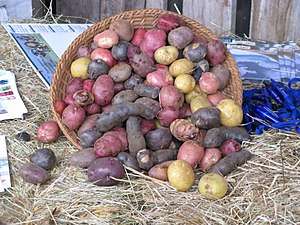Potatoes of Chiloé
The Chiloé Archipelago is home to a wide variety of potatoes. After the Titicaca region of Peru and Bolivia, it is the geographical nucleus where the most different types of potatoes are found. Evidence ranging from historical records, local agriculturalists, and DNA analyses strongly supports the hypothesis that the most widely cultivated variety of potato worldwide, Solanum tuberosum tuberosum, is indigenous to the Chiloé Archipelago, and has been cultivated by the local indigenous people since before the Spanish conquest.[1][2] Contrary to potatoes from Peru and Bolivia the potatoes of Chiloé are adapted to the long-day conditions prevalent in the higher latitude region of southern Chile.[1] Local varieties include Camota, Cielo, Pachacoña, Cabrita, Chelina, Guadacho Colorada, Zapatona, Michuñe Azul, Huicaña and Ñocha.

Guaitecas Archipelago
Some of the potatoes of Chiloé also grow in the wild in Guaitecas Archipelago, although there is some uncertainty as to when and how potatoes arrived there.[3] The Guaitecas Archipelago formed the southern limit of Pre-Hispanic agriculture[4] as noted by the mention of the cultivation of potatoes by a Spanish expedition in 1557.[3] Later during the second voyage of HMS Beagle, Charles Darwin collected potatoes from Guaitecas.[3]
Potatoes grow beside the sea in a herbaceous zone. The wild potatoes that grow in the archipelago are mostly found in its western part. Apparently these potatoes do not reproduce by seeds and rarely produce flowers and fruits.[3] Potatoes grow in zones of disturbance, mainly in the herbaceous zone near the coast that is affected by winter storms.[3]
- Guadachos variety
- Michuñe Blanca variety
- Michuñe Roja variety
References
- Solano Solis, Jaime; Morales Ulloa, Daniza; Anabalón Rodríguez, Leonardo (July 2007). "Molecular description and similarity relationships among native germplasm potatoes (Solanum tuberosum ssp. tuberosum L.) using morphological data and AFLP markers". Electronic Journal of Biotechnology. 10 (3): 436–443. doi:10.2225/vol10-issue3-fulltext-14. hdl:10925/320. Retrieved 6 December 2009.
- Using DNA, scientists hunt for the roots of the modern potato, January 2008
- Contreras, Andrés; Ciampi, Luigi; Padulosi, Stefano; Spooner, David M. (1993). "Potato germplasm collecting expedition to the Guaitecas and Chonos Archipelagos, Chile, 1990". Potato Research. 36 (4): 309–316. doi:10.1007/BF02361797.
- Bird, Junius (1946). "The Alacaluf". In Steward, Julian H. (ed.). Handbook of South American Indians. Bulletin 143. I. –Bureau of American Ethnology. pp. 55–79.